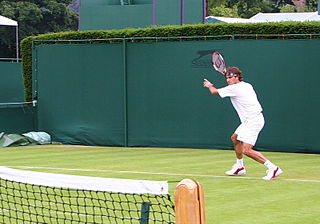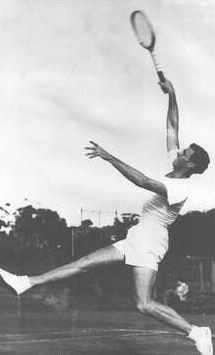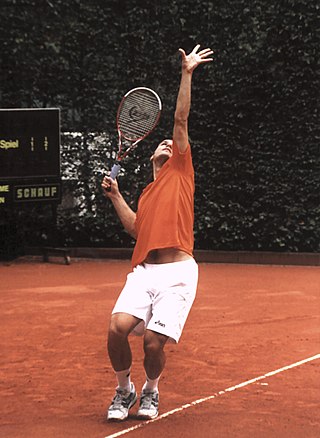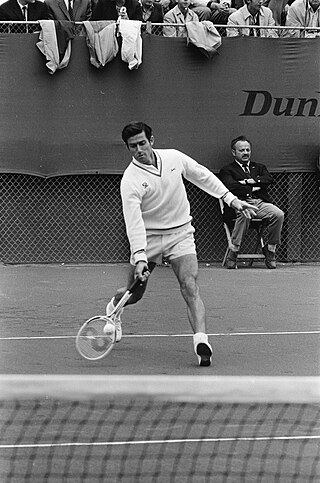
Tennis is a racket sport that is played either individually against a single opponent (singles) or between two teams of two players each (doubles). Each player uses a tennis racket strung with a cord to strike a hollow rubber ball covered with felt over or around a net and into the opponent's court. The object is to manoeuvre the ball in such a way that the opponent is not able to play a valid return. If a player is unable to return the ball successfully, the opponent scores a point.

Rodney George Laver is an Australian former tennis player. Laver was ranked the world number 1 professional player indisputably for five years from 1965 to 1969 and by some sources also in 1964 and 1970. He was also ranked as the number 1 amateur in 1961 and 1962. Laver won 198 singles titles which is the most won by a player in history.

Lewis Alan Hoad was an Australian tennis player whose career ran from 1950 to 1973. Hoad won four Major singles tournaments as an amateur. He was a member of the Australian team that won the Davis Cup four times between 1952 and 1956. Hoad turned professional in July 1957. He won the Kooyong Tournament of Champions in 1958 and the Forest Hills Tournament of Champions in 1959. He won the Ampol Open Trophy world series of tournaments in 1959, which included the Kooyong tournament that concluded in early January 1960. Hoad's men's singles tournament victories spanned from 1951 to 1971.

Kenneth Robert Rosewall is an Australian former world top-ranking professional tennis player. Rosewall won 147 singles titles, including a record 15 Pro Majors and 8 Grand Slam titles for a total 23 titles at pro and amateur majors ranks him second all time to Novak Djokovic on 24. He also won 15 Pro Majors in doubles and 9 Grand Slam doubles titles. Rosewall achieved a Pro Slam in singles in 1963 by winning the three Pro Majors in one year and he completed the Career Grand Slam in doubles.

A grass court is one of the types of tennis court on which the sport of tennis, originally known as "lawn tennis", is played. Grass courts are made of grasses in different compositions depending on the tournament.
A volley in tennis is a shot where the ball is struck before it bounces on the ground. Typically, a player hits a volley while standing near the net, though it can be executed further back, in the middle of the tennis court, or even near the baseline. The word derives from M. French volée meaning flight.
A half volley in tennis is a shot that is hit immediately after the ball bounces but before it reaches the apex of its bounce. It is sometimes called an "on the rise shot", or "short hop".

The forehand is a shot used in most racket sports, such as tennis, table tennis and pickleball, where the palm of the hand precedes the back of the hand when swinging the racket. In tennis, except in the context of the phrase forehand volley, the term refers to a type of groundstroke—a stroke in which the ball has bounced before it is struck. It contrasts with the backhand, the other type of groundstroke. For a right-handed player, the forehand is a stroke that begins on the right side of the body, continues across the body as contact is made with the ball, and ends on the left side of the body. It is considered the easiest shot to master, perhaps because it is the most natural stroke. Beginners and advanced players often have better forehands than any other shots and use it as a weapon.

The backhand is a shot used in most racket sports, such as tennis, table tennis and pickleball, where the back of the hand precedes the palm when swinging the racket. Except in the phrase backhand volley, the term refers to a groundstroke. It contrasts with the forehand stroke, where the palm precedes the back of the hand. The term is also used in other sports where a similar motion is employed, such as throwing a sport disc.
In racket sports a groundstroke, or ground stroke, refers to a forehand or backhand shot that is executed after the ball has bounced on the court. The term is commonly used in the sports of tennis and pickleball, and is counter to a volley shot which is taken before the ball has bounced. Groundstrokes in tennis are usually hit from the back of the court, around the baseline.

A lob in tennis involves hitting the ball high and deep into the opponent's court. It can be used as an offensive or defensive weapon.

A smash in tennis is a shot that is hit above the hitter's head with a serve-like motion. It is also referred to as an overhead. A smash can usually be hit with a high amount of force and is often a shot that ends the point. Most smashes are hit fairly near the net or in mid-court before the ball bounces, generally against lobs that have not been hit high enough or deep enough by the opponent. A player can also smash a very high ball from the baseline, generally on the bounce, although this is often a less forceful smash.
In tennis, there are a variety of types of shots which can be categorized in various ways. The serve is the opening shot of a point, and it's typically struck using an overhead throwing motion. Shots struck during the point are categorized into two major categories: groundstrokes, which are hit after the ball has bounced, and volleys, which are hit out of the air. Both groundstrokes and volleys can be further classified as either forehands or backhands, with the classification determined by the side of the body on which the ball is hit.
This page is a glossary of tennis terminology.
Players use different strategies while playing tennis to enhance their own strengths and exploit their opponent's weaknesses in order to gain the advantage and win more points.

Frederick Rudolph "Ted" Schroeder was an American tennis player who won the two most prestigious amateur tennis titles, Wimbledon and the U.S. National. He was the No. 1-ranked American amateur player in 1942; the No. 2 for 4 consecutive years, 1946 through 1949, and the latter year saw Schroeder ranked World No. 1 amateur by Pierre Gillou. He was born in Newark, New Jersey, but developed as a tennis player in Southern California under the guidance of Perry T. Jones.
The following outline is provided as an overview of and topical guide to tennis.

A passing shot is a forceful shot, as in tennis or team handball, that travels to one side out of the reach of one's opponent. In tennis, this shot is generally a groundstroke and is used when one's opponent is running to the net or if they are at the net already. The alternative to a passing shot is to lob the ball over the opponent's head. The aim of the passing shot in tennis is to prevent the opponent from returning the ball once he/she is at the net.

A serve in tennis is a shot to start a point. A player will hit the ball with a racquet so it will fall into the diagonally opposite service box without being stopped by the net. Normally players begin a serve by tossing the ball into the air and hitting it. The ball can only touch the net on a return and will be considered good if it falls on the opposite side. If the ball contacts the net on the serve but then proceeds to the proper service box, it is called a let; this is not a legal serve in the major tours although it is also not a fault. Players normally serve overhead; however serving underhand is allowed. The serve is the only shot a player can take their time to set up instead of having to react to an opponent's shot; however, as of 2012, there is a 25-second limit to be allowed between points.

The Gonzales–Rosewall rivalry was a tennis rivalry between Pancho Gonzales and Ken Rosewall, widely regarded as two of the greatest tennis players of all time. This rivalry featured some of the most acclaimed matches in tennis history, and was the most prolific tennis rivalry of all time.












